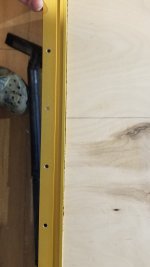Hey guys, Im having trouble making a straight cut with my track saw while bevel cutting.
When I've got the saw set to 45 degrees I'm consistently getting a slight arc to the cut line.
However, when the saw is set to 0 degrees the cut line is straight.
I've tried clamping the track and also with no clamps and the results are the same. I get a ~0.5mm gap at the center of a cut when a straight edge is held up to it.
Anyone else have this issue?
When I've got the saw set to 45 degrees I'm consistently getting a slight arc to the cut line.
However, when the saw is set to 0 degrees the cut line is straight.
I've tried clamping the track and also with no clamps and the results are the same. I get a ~0.5mm gap at the center of a cut when a straight edge is held up to it.
Anyone else have this issue?

